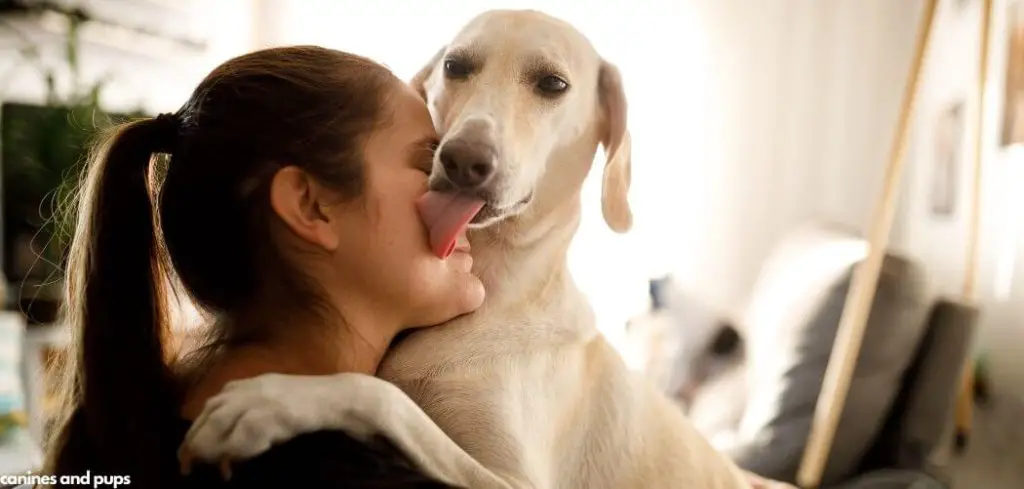A dog panting and pawing at you can be confusing and sometimes alarming. These behaviors may indicate excitement or affection or underlying medical issues.
We outline the common reasons why your dog may pant and paw at you, what you can do, and when to seek veterinary help.
Table of Contents
Dog Panting and Pawing at Me — Why It Happens
When a dog is panting and pawing at you, it’s usually trying to communicate discomfort, anxiety, or a need for reassurance. Panting can indicate stress, heat, or pain, while pawing is a dog’s way of seeking your attention or comfort.
This behavior often happens during stressful events like thunderstorms, fireworks, or when your dog feels unwell or scared.
Sometimes, it’s a sign of separation anxiety or a learned behavior where your dog knows pawing gets a response.

Dog Panting and Pawing at Me: Common Causes
Anxiety or Stress
Anxiety is one of the most common reasons dogs pant and paw at their owners.
Dogs experiencing separation anxiety, fear of loud noises, or general stress may seek reassurance from their owners through pawing while also panting due to increased heart rate.
You may notice trembling, pacing, whining, or hiding in addition to pawing. Behavioral modification techniques, consistent routines, and in some cases, veterinary-prescribed anti-anxiety medications can help reduce these behaviors.
Read more: Dog Panting and Jumping on Me (Here’s why)
Attention-Seeking or Excitement
Many dogs paw at their owners and pant simply to get attention. This is especially common in energetic or social breeds.
Pawing is a way of communicating that they want interaction, treats, playtime, or petting.
Signs include wagging tails, jumping, or bringing toys. Reinforcing calm behaviors with positive attention rather than rewarding frantic pawing can help teach your dog more controlled ways to get your attention.
Pain or Discomfort
Pain or discomfort can cause panting and pawing at you. Dogs may not always vocalize distress, but pawing can be a signal that something is wrong. Panting may occur due to stress or pain-related increased body temperature.
Look for limping, difficulty moving, sensitivity when touched, or changes in appetite. Veterinary evaluation is necessary to identify conditions such as arthritis, injuries, or internal health issues causing the discomfort.
Nausea or Digestive Issues
Digestive upset can prompt dogs to pant and paw at their owners. Nausea, bloating, or gastrointestinal discomfort can make a dog restless and seek comfort from a familiar person.
Symptoms may include vomiting, drooling, loss of appetite, or abdominal bloating. Timely veterinary care is essential, especially if symptoms persist, to prevent dehydration or worsening illness.
Cognitive Dysfunction or Confusion
Older dogs may pant and paw at their owners due to cognitive dysfunction. Age-related confusion, memory loss, or disorientation can cause restlessness and repetitive behaviors. Panting may accompany these behaviors as a sign of stress or confusion.
Other signs include night-time pacing, altered sleep patterns, and forgetting previously learned commands. Management includes environmental enrichment, routine, and veterinary support to slow cognitive decline.
Hormonal or Metabolic Disorders
Hormonal imbalances, such as hyperthyroidism or Cushing’s disease, can cause panting and pawing behaviors.
These disorders affect energy levels, stress responses, and overall comfort, which can result in your dog seeking reassurance through pawing.
Watch for changes in thirst, urination, appetite, weight, or coat quality. Veterinary diagnosis through blood work and hormone testing is required to confirm and manage these conditions.
What to Do If Your Dog Is Panting and Pawing at You
Maintain a calm environment and provide reassurance without inadvertently rewarding anxious behavior. Consistent training and positive reinforcement for calm behaviors can help manage attention-seeking or anxious pawing.
Monitor your dog for additional symptoms like vomiting, limping, changes in appetite, or unusual lethargy, which may indicate medical issues.
Ensure your dog has regular exercise and mental stimulation to reduce restlessness and excess energy that may manifest as pawing.
Maintain a regular feeding schedule and provide fresh water to support metabolic health and reduce stress-related behaviors.
Keep a journal of when pawing occurs, associated panting, and any environmental triggers. This record can assist your veterinarian in diagnosing potential underlying causes.
When to Call or Visit Your Vet
Immediate veterinary attention is recommended if your dog shows:
Persistent or labored panting
Pawing accompanied by vocalizations of distress or signs of pain
Vomiting, diarrhea, or sudden loss of appetite
Lethargy, collapse, or fainting
Suspected hormonal, metabolic, or cognitive issues
Early evaluation ensures that serious medical conditions are identified and treated promptly, improving your dog’s comfort and quality of life.
Read more: Dog Panting and Licking Me (What it means)
Key Takeaway
Panting and pawing at you can indicate anything from normal attention-seeking to signs of anxiety, pain, or medical issues.
Observing your dog’s behavior, maintaining a calm and consistent environment, and seeking veterinary guidance when needed ensures your dog stays healthy, comfortable, and emotionally secure.
